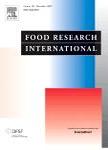版权所有:内蒙古大学图书馆 技术提供:维普资讯• 智图
内蒙古自治区呼和浩特市赛罕区大学西街235号 邮编: 010021

作者机构:Southwest Univ Coll Food Sci 2 Tiansheng Rd Chongqing 400715 Peoples R China Yangzhou Univ Sch Food Sci & Engn Yangzhou 225127 Jiangsu Peoples R China Minist Agr & Rural Affairs Peoples Republic of Chi Lab Qual & Safety Risk Assessment Agroprod Storage Chongqing 400715 Peoples R China Chinese Hungarian Cooperat Res Ctr Food Sci Chongqing 400715 Peoples R China Chongqing Key Lab Speciality Food Co-Built Sichuan Chongqing 400715 Peoples R China
出 版 物:《FOOD RESEARCH INTERNATIONAL》 (国际食品研究)
年 卷 期:2022年第162卷第PartA期
页 面:111964页
核心收录:
学科分类:0832[工学-食品科学与工程(可授工学、农学学位)] 08[工学]
基 金:National Natural Science Foundation of China 32072341
主 题:Zanthoxylum schinifolium Sieb et Zucc Bitter sensory evaluation Bitter component Transcriptomics Metabolomics Biosynthesis
摘 要:The perceptible bitterness of Zanthoxylum schinifolium Sieb. et Zucc is an important factor limiting its con-sumption. Metabolomics was used to identify potentially bitter metabolites during the development of Z. schinifolium, and dynamic changes in 17 key bitter components were characterized. The key bitter components in Z. schinifolium at different developmental stages were mainly synthesized through the phenylpropanoid biosynthesis, flavonoid biosynthesis, and flavone and flavonol biosynthesis pathways. In combination with transcriptomic data, the expression of related genes regulates the accumulation process of these bitter compo-nents;based on this, a biosynthetic pathway of bitter components in Z. schinifolium was constructed. In addition, quercetin-3-galactoside, isoquercitin, quercitrin, kaempferol, and isorhamnetin were identified as the main sources of bitterness in mature Z. schinifolium based on an evaluation of taste activity value. These findings provide valuable information for understanding mechanisms underlying Z. schinifolium bitterness and promoting the further development of high-quality Z. schinifolium.